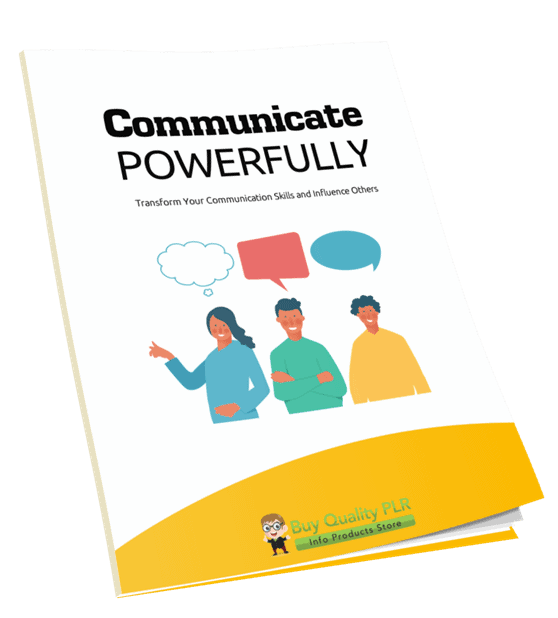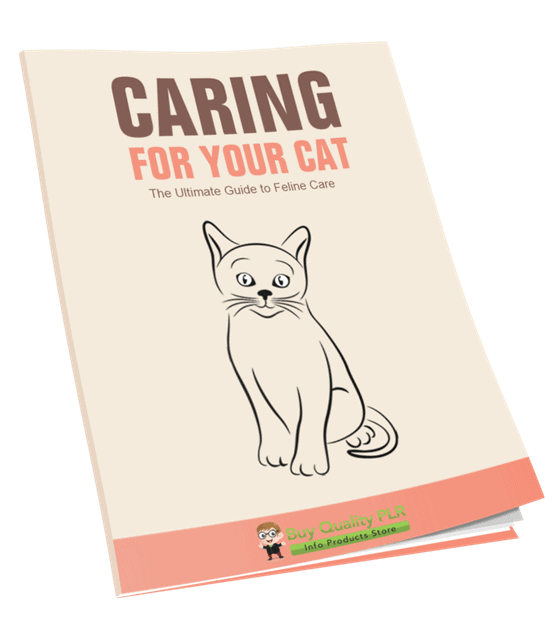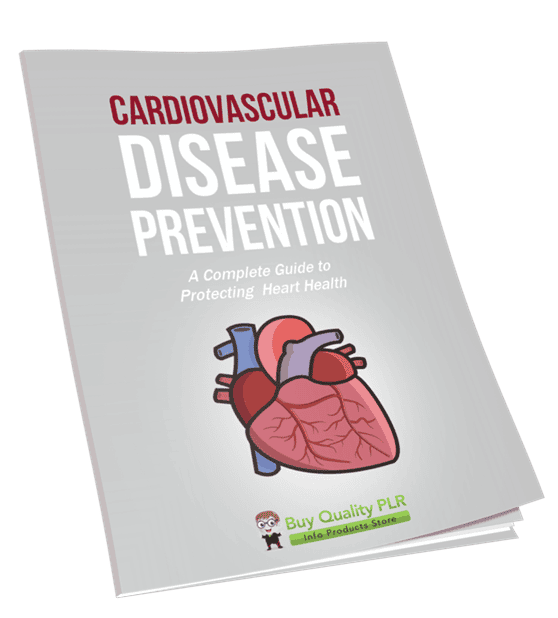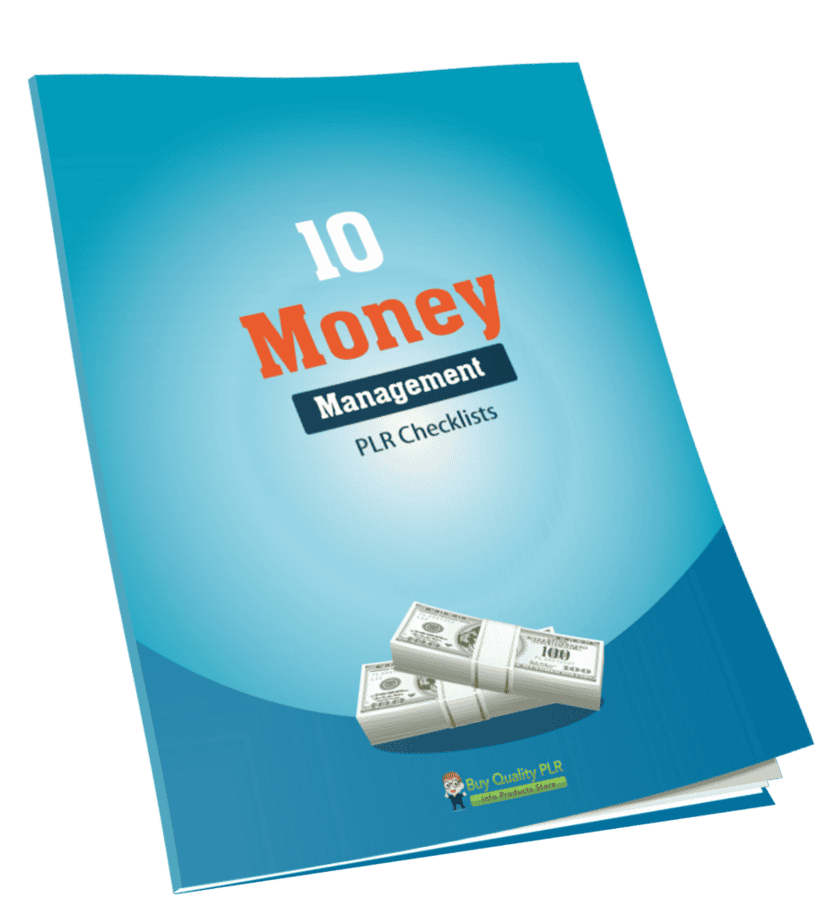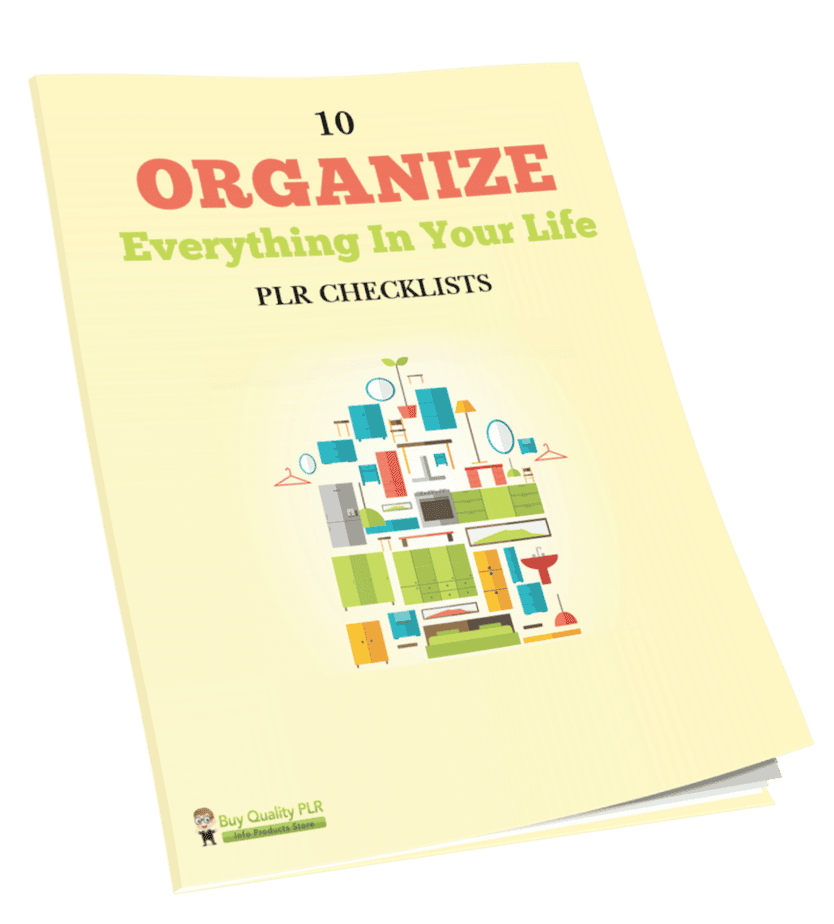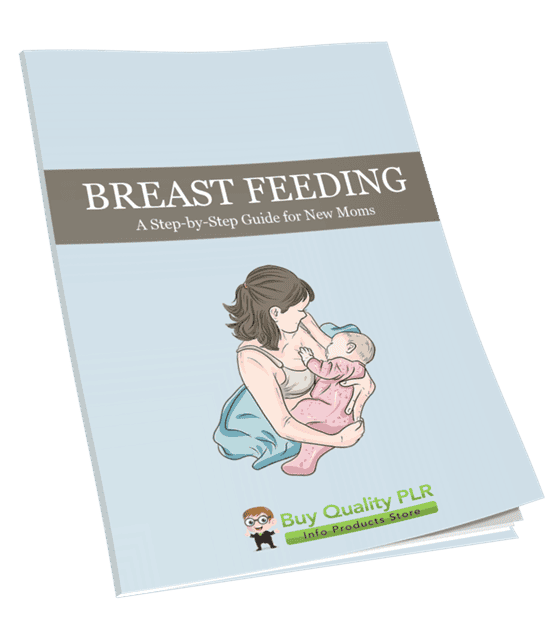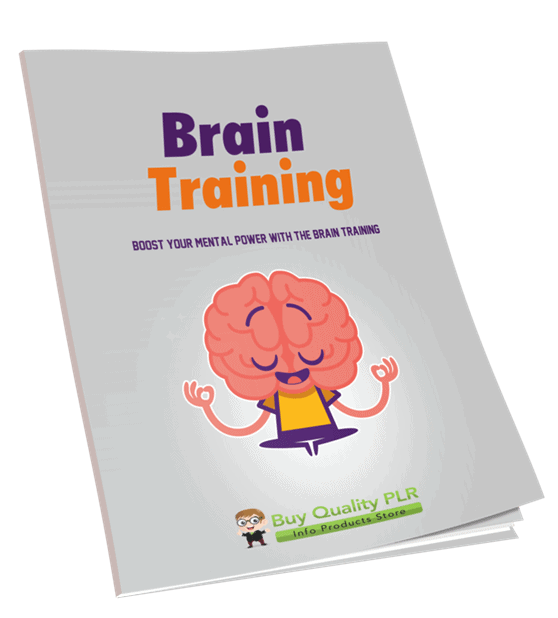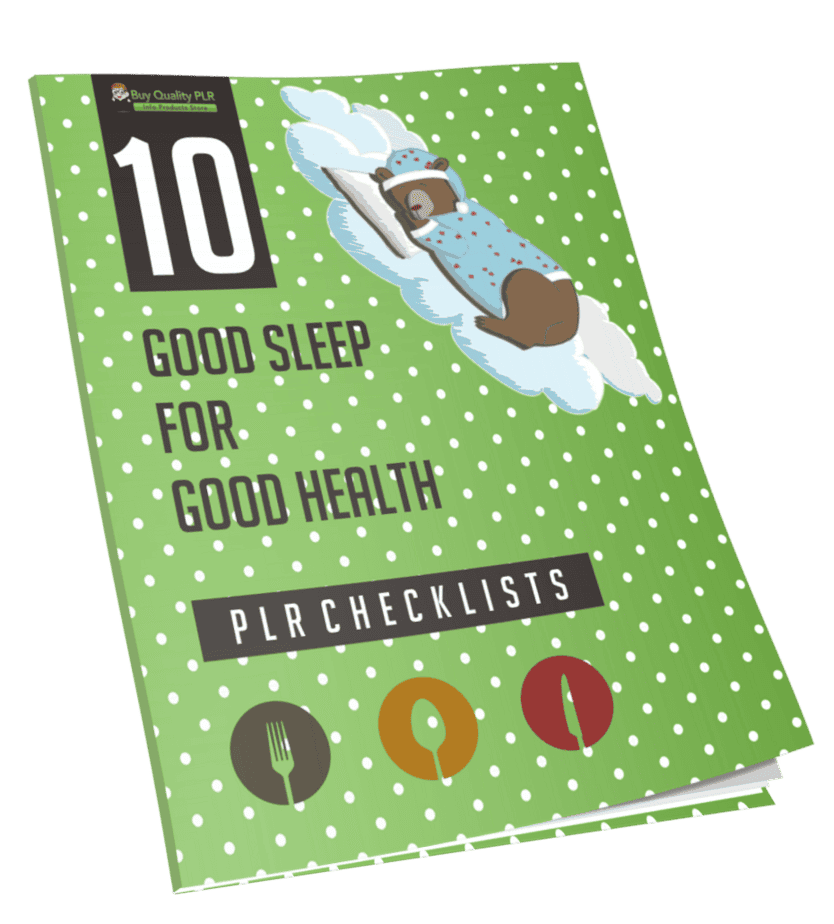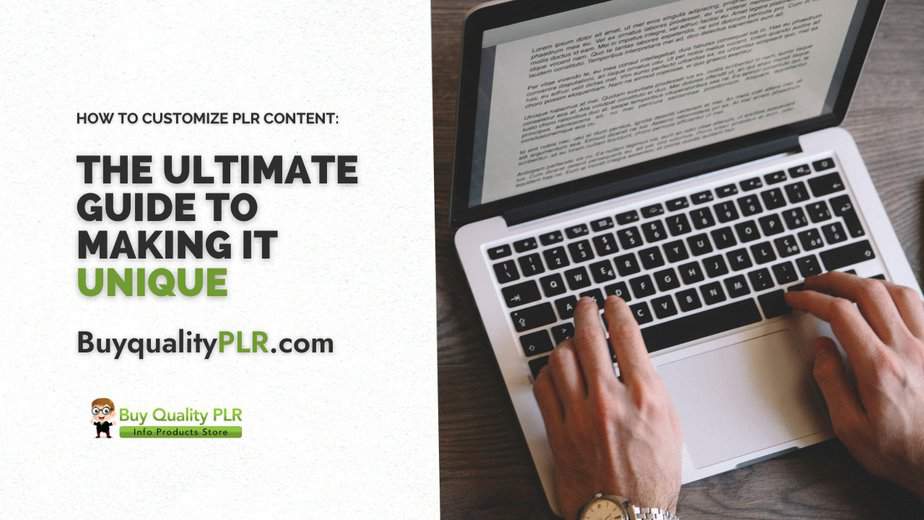
How to Customize PLR Content: The Ultimate Guide to Making it Unique
in Business Models, Content Marketing, Digital Products, Email Marketing, Internet Marketing, Lead Magnets, List Building, Make Money Online, Making PLR Unique, Online Home Business, PLR Content, PLR Products, PLR Rebranding, Private Label Rights, Product Creation, Using PLR#howtocustomize #repurposingplr #customizingplr #plrcontent #plrcontentguide #customizingplrcontent #editingplr #editingplrcontent #usingplr #makingcontentunique
Transform PLR Content: The Ultimate Guide to Customization and Uniqueness
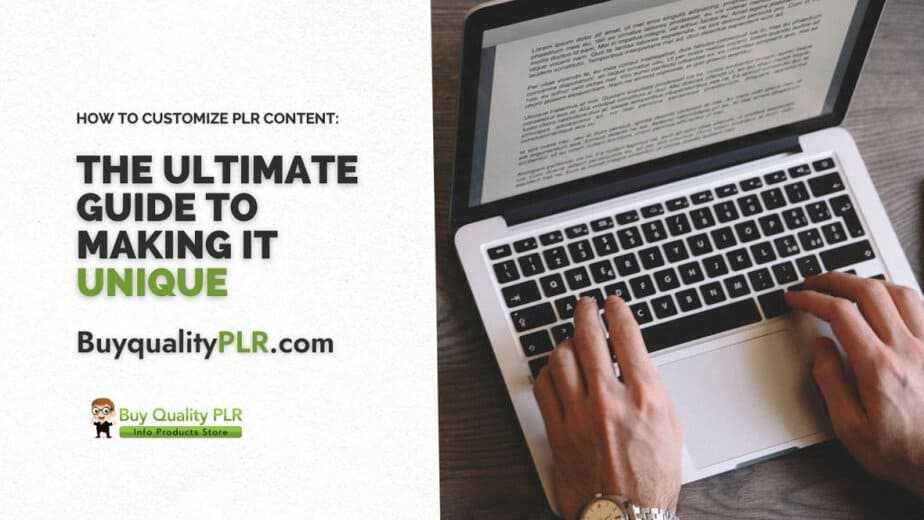
Introduction
Private Label Rights (PLR) content is a type of digital product that you purchase with a license allowing you to modify, rebrand, and sell it as your own. This pre-made content comes in various forms, such as articles, ebooks, courses, templates, and graphics, saving you time and effort when creating original content from scratch.
Benefits of PLR Content:
- Cost-Effective: PLR content is significantly cheaper than hiring a professional content creator or developing materials from scratch.
- Time-Saving: You can quickly access and customize pre-made content, saving you valuable time on research and creation.
- Versatile: You can use PLR content for a variety of things, including lead magnets, blog posts, social media content, online courses, and products for sale.
- Easy to Customize: You can modify and personalize PLR content to match your brand voice, style, and target audience.
- Diverse Range of Topics: PLR content is available in a wide range of niches, allowing you to find relevant material for your specific needs.
- Potential for Passive Income: By selling or using PLR content to generate leads and traffic, you can create a passive income stream.
PLR content can be a valuable tool for entrepreneurs, bloggers, marketers, and anyone seeking to create and share high-quality content without starting from scratch. By understanding the licensing terms and choosing reputable providers, you can leverage PLR content to achieve your business goals and maximize your online presence.
Transforming PLR Content: Why Customization is Key to Success
Private Label Rights (PLR) content is a fantastic resource for quickly acquiring high-quality content. However, simply using PLR content “as is” can be detrimental to your brand’s success. Customizing and transforming PLR into unique, valuable content that resonates with your specific audience is the real power of this content.
Why Customization is Crucial:
- Differentiation: The PLR market is vast, and chances are, others have purchased the same content as you. Customizing allows you to set yourself apart from the competition and create a unique brand identity.
- Relevance: Tailoring the content to your niche and target audience ensures that it speaks directly to their needs and interests, increasing engagement and conversions.
- Authority Building: By adding your unique insights, expertise, and experiences to the content, you establish yourself as a knowledgeable authority in your field.
- SEO Benefits: Search engines favor unique and valuable content. Customizing PLR helps you avoid duplicate content issues and improve your search engine rankings.
- Higher Perceived Value: Customized content appears more valuable to your audience, allowing you to charge premium prices and increase your profits.
Think of PLR content as a blueprint or a starting point. By adding your own flair, creativity, and expertise, you can turn it into a masterpiece that truly represents your brand and resonates with your audience. This will not only help you stand out in a crowded market but also build a loyal following of customers who value your unique perspective and offerings.
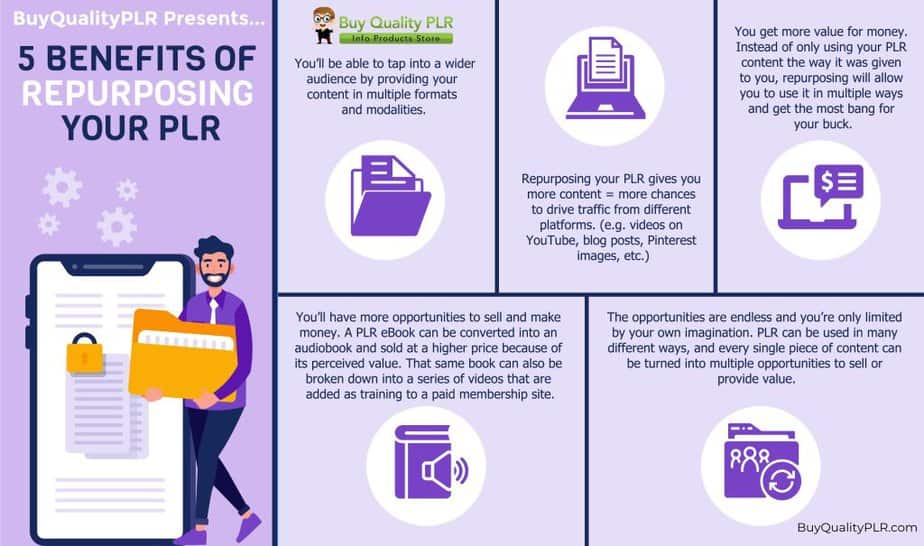
Unlocking the Power of PLR: Your Guide to Customization for Maximum Impact
In this comprehensive guide, we’ll delve into the world of Private Label Rights (PLR) content and reveal the secrets to transforming generic material into unique, high-quality assets that resonate with your audience and drive your business forward. We’ll cover everything from understanding PLR licensing to mastering customization techniques for various content types. By the end, you’ll possess the knowledge and tools necessary to transform PLR content into a valuable asset for your brand.
Key Takeaways:
- Understanding the fundamentals of PLR licensing and its significance to your business is critical.
- Learn how to strategically select PLR content that aligns with your niche and audience.
- You can master the art of customization to make PLR content truly your own.
- We are exploring different customization techniques for various content types, from articles and ebooks to courses and social media posts.
- We are discovering tools and resources that streamline the customization process.
- Learn how to effectively market and promote your customized PLR content.
By the end of this guide, you’ll be well-equipped to unlock the full potential of PLR content and leverage it to achieve your business goals. Let’s dive in and transform your PLR content into a powerful asset!
Understanding PLR Licensing: Navigating Usage Rights and Restrictions
PLR licenses vary in terms of the rights and restrictions they grant to the purchaser. It’s crucial to understand these differences to avoid potential legal issues and ensure you’re using the content appropriately.
Here’s a breakdown of common PLR license types:
- Personal Use Rights (PUR):
- Usage: This license allows you to use the content for your own personal or internal purposes.
- Restrictions: You cannot modify, rebrand, or resell the content in any way.
- Resell Rights (RR):
- Usage: This license allows you to resell the content “as is” to your customers or clients.
- Restrictions: You are typically unable to modify or claim ownership of the content.Your customers also cannot resell the content further.
- Master Resell Rights (MRR):
- Usage: This license gives you the right to resell the content, as well as allowing your customers to resell it.
- Restrictions: You and your customers may not modify the content or claim ownership.
- Resell PLR (RPLR):
- Usage: Similar to PLR, this license allows you to edit and modify the content before reselling it. You can also grant PLR rights to your customers, allowing them to further modify and resell the content.
- Restrictions: It is important to review the seller’s specific license terms, as restrictions can vary.
- Private Label Rights (PLR):
- Usage: This license offers a great deal of flexibility. You have the option to modify, rebrand, and resell the content as your own. You can also give it away as a bonus, include it on a membership site, or use it for content marketing.
- Restrictions: Most PLR licenses dictate that you can only sell the content in a non-editable format like PDF. Some PLR licenses may allow you to edit and sell resell rights; however, this varies from seller to seller. Always carefully read the terms and conditions of the license before purchasing.
- Giveaway Rights:
- Usage: This license allows you to distribute the content for free as a lead magnet or bonus.
- Restrictions: You may not sell or claim ownership of the content.
- Unrestricted PLR:
- Usage: This license offers the most extensive rights, allowing you to use the content in any way you see fit, with no limitations or restrictions.
Before purchasing, always carefully read the terms and conditions of each PLR license to ensure you understand the specific rights and restrictions associated with the content.
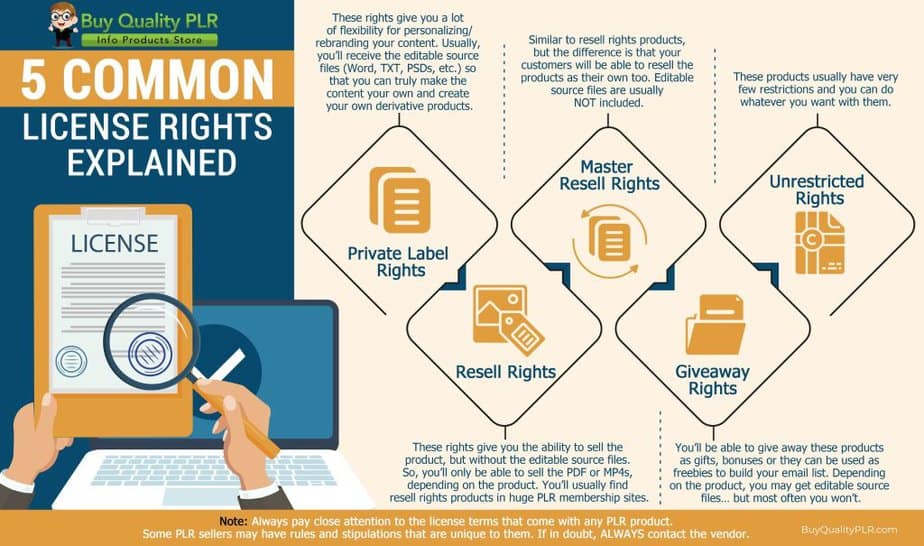
The Importance of Adhering to Licensing Terms to Avoid Legal Issues
PLR licenses vary in terms of the rights and restrictions they grant to the purchaser. It’s absolutely critical to thoroughly understand and meticulously adhere to these terms in order to avoid potential legal issues and ensure you’re using the content appropriately. Violating licensing terms can lead to copyright infringement claims, lawsuits, and significant damage to your reputation.
Failure to comply with licensing terms could result in the following consequences:
- Copyright Infringement: If you exceed the permitted usage rights, such as selling PLR content without the right to do so or claiming authorship of unmodified content, you could face legal action from the original creator.
- Financial Penalties: Copyright infringement can lead to hefty fines and legal fees, potentially causing significant financial strain on your business.
- Reputational Damage: Accusations of plagiarism or copyright infringement can harm your brand’s reputation and erode audience trust, resulting in lost customers and business opportunities.
Best Practices for Adhering to PLR Licensing Terms:
- Read Thoroughly: Always carefully read and understand the terms and conditions of each PLR license before purchasing.
- Keep Records: Maintain records of your PLR purchases, including the license terms and any modifications you’ve made to the content.
- Seek Clarification: If you’re unsure about any aspect of a PLR license, contact the provider for clarification before using the content.
- Consult a Legal Professional: If you have any doubts about the legality of your PLR usage, seek advice from a lawyer specializing in intellectual property law.
Respecting and adhering to PLR licensing terms can protect you from legal issues, as well as help you build a sustainable and ethical business based on PLR content. Remember, responsible use of PLR is essential for maintaining a positive reputation and ensuring the long-term success of your ventures.
Elevating PLR: Unveiling the Value of Customization
While PLR content offers a convenient and cost-effective foundation, the true potential for maximizing its value lies in customization. Going beyond simply rebranding, customization empowers you to create unique, high-quality content that resonates with your audience and drives tangible results.
Here’s how customization amplifies the value of your PLR investment:
- Distinct Brand Identity: In a sea of generic content, customization allows you to infuse your brand’s unique voice, style, and personality into PLR materials. This creates a distinct identity that sets you apart from competitors and fosters recognition among your target audience.
- Enhanced Relevance and Engagement: Tailoring PLR content to your specific niche and audience ensures it addresses their unique needs, challenges, and interests. This personalized approach increases engagement, builds trust, and fosters a stronger connection with your audience.
- Authority Building: By adding your own expertise, insights, and experiences to PLR content, you position yourself as a knowledgeable authority in your field. This builds credibility and trust, attracting a loyal following of customers who value your unique perspective and guidance.
- Improved SEO Performance: Search engines favor unique and relevant content. Customizing PLR content helps you avoid duplicate content penalties and improves your search engine rankings, driving more organic traffic to your website or platform.
- Increased Perceived Value: Customized content appears more valuable and professional, justifying higher price points and boosting your profit margins. By tailoring your offerings to specific needs, you can attract customers who are willing to pay a premium for your unique solutions.
- Greater Marketing Effectiveness: Personalized PLR content resonates more deeply with your audience, making it more likely to be shared and promoted organically. This word-of-mouth marketing can significantly expand your reach and attract new customers.
- Competitive Advantage: In a crowded market, customization gives you a competitive edge. Your unique, high-quality content will stand out from the generic offerings of others, attracting and retaining customers who value your brand’s unique value proposition.
By investing time and effort in customizing your PLR content, you transform it from a generic template into a powerful asset that drives engagement, builds authority, and fuels your business growth. Remember, customization is not just about changing a few words or adding your logo; it’s about infusing your unique essence into the content to create something truly valuable and impactful.

Laying the Groundwork: Choosing the Right PLR Content for Customization
Before diving into the customization process, it’s crucial to select the right PLR content that aligns with your niche and target audience. This ensures that your efforts will yield the most relevant and engaging results, ultimately maximizing the value of your investment. Here’s how to strategically choose PLR content for customization:
Define Your Niche and Audience:
- Clarity is Key: Clearly articulate your niche and the specific segment of your audience you want to target. Understand their pain points, desires, and interests. The more specific you can be, the easier it will be to find PLR content that resonates with them.
- Research Your Audience: Conduct thorough research to identify the types of content your audience consumes and the platforms they frequent. This will help you tailor your PLR selection accordingly.
Identify Content Gaps:
- Analyze Existing Content: Assess your current content library and identify areas where you lack expertise or need fresh perspectives. Look for PLR content that can fill these gaps and provide valuable information to your audience.
- Stay Updated on Trends: Keep abreast of the latest trends and topics in your niche. Seek PLR content that addresses these emerging trends to keep your content relevant and engaging.
Prioritize Quality Over Quantity:
- Reputable Providers: Choose PLR content from reputable providers known for their high-quality standards. Look for providers with positive reviews, testimonials, and a track record of delivering valuable content.
- Preview Samples: Before purchasing, request samples or excerpts of the PLR content to assess its quality, relevance, and writing style.
Match Content Format to Your Needs:
- Diverse Formats: Consider the various formats available, such as articles, ebooks, courses, videos, and graphics. Choose formats that align with your content strategy and preferred delivery methods.
- Length and Depth: Assess the content’s length and depth to ensure it matches your needs and your audience’s attention span.
Look for Customization Potential:
- Editable Formats: Opt for PLR content that comes in editable formats like Word documents, PowerPoint presentations, or text files. This will allow you to easily modify and personalize the content.
- Licensing Terms: Carefully review the licensing terms to ensure they allow for the level of customization you desire, including rebranding and reselling rights.
You can strategically choose PLR content that fits your niche, connects with your audience, and has the potential to become distinctive, valuable assets for your business by adhering to these guidelines.
Ensuring Quality and Relevance: Evaluating PLR Content Before You Commit
Once you’ve identified potential PLR content that aligns with your niche and audience, the next crucial step is evaluating its quality and relevance. This ensures that the content you choose is worth your investment and will effectively contribute to your goals. Here’s a detailed approach to assessing PLR content:
Scrutinize the Writing:
- Clarity and Conciseness: Is the writing clear, concise, and easy to understand? Avoid using content with convoluted sentences or jargon that may alienate your audience.
- Grammar and Spelling: Check for grammatical errors, typos, or inconsistencies. Poorly written content can reflect negatively on your brand.
- Flow and Structure: Does the content flow logically and maintain a clear structure? Look for well-organized paragraphs, headings, and subheadings that guide the reader through the material.
- Tone and Style: Evaluate the writing’s tone and style. Does it fit your brand’s voice and resonate with your target audience?
Assess the Information:
- Accuracy and Relevance: Verify that the information presented is accurate. Is it up-to-date and relevant to your niche and target audience? Outdated or inaccurate information can damage your credibility.
- Depth and Value: Does the content provide in-depth insights, actionable advice, or valuable information? Avoid shallow or superficial content that doesn’t offer real value to your audience.
- Uniqueness: Evaluate how unique and original the content is. While PLR content is meant to be customized, it should still offer a fresh perspective or unique angle on the topic.
Consider the Design and Formatting:
- Visual Appeal: If the PLR content includes graphics, images, or layout elements, assess their quality and visual appeal. Ensure they are professional and align with your brand’s aesthetic.
- Readability: Check the formatting for readability. Are the fonts simple to read? Is there enough white space? Is the layout organized and easy to follow?
Review Testimonials and Ratings:
- Other Buyers’ Feedback: If available, read reviews and testimonials from other buyers to gauge their experiences with the PLR content and the provider.
- Ratings and Reviews: Check online platforms or forums for ratings and reviews of the PLR provider and their products.
Request Samples or Previews:
- Sample Content: Many PLR providers offer samples or excerpts of their content. You should request these samples to gauge the writing style, quality, and relevance of the content before making a purchase.
- Preview Videos: If the PLR content is a course or video series, ask if you can preview a few modules to assess the production quality and teaching style.
By taking the time to thoroughly evaluate the quality and relevance of PLR content, you can make informed decisions and choose the best resources to enhance your business and provide value to your audience. Remember, investing in high-quality PLR content is an investment in your brand’s success.
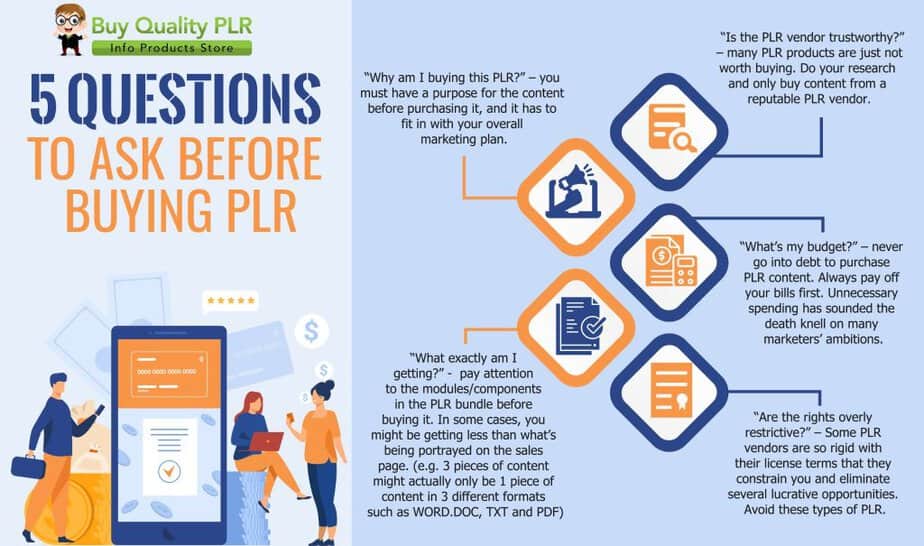
Taming the PLR Jungle: Organizing Your Content for Efficiency and Ease
As your PLR library grows, maintaining organization becomes essential for streamlined access and efficient use. A well-structured system will save you time, prevent content duplication, and ensure you can quickly find the right resources for your projects. Here are some tips for organizing your PLR content:
Categorize by Niche or Topic:
- Create Clear Folders: Divide your PLR content into folders based on broad niches or specific topics. For example, you might have folders for “Health & Wellness,” “Business & Marketing,” “Personal Development,” etc.
- Subfolders for Specificity: Within each main folder, create subfolders for more specific topics. This will make it easier to locate relevant content when you need it.
Label with Keywords and Descriptions:
- Descriptive Filenames: Give each file a descriptive name that includes relevant keywords and a brief description of the content. For example, “weight-loss-ebook-plr-with-graphics” or “social-media-marketing-article-plr-500-words.”
- Tags or Metadata: Use tags or metadata to add additional keywords or information about the content, such as the date of purchase, licensing terms, or intended use.
Utilize Cloud Storage:
- Google Drive/Dropbox: Cloud storage platforms like Google Drive or Dropbox offer a convenient way to store and access your PLR content from any device. They also enable easy sharing and collaboration with team members or virtual assistants.
- Folder Syncing: Set up folder syncing to automatically update your PLR library across all your devices, ensuring you always have the latest version of your content.
Leverage PLR Management Tools:
- Airtable/Notion: These versatile database tools can be customized to create a comprehensive PLR content library. You can track details like purchase dates, licensing terms, topics, formats, and even add notes or reviews.
- Evernote/OneNote: These note-taking apps can be used to organize your PLR content ideas, research notes, and outlines.
Maintain a Content Calendar:
- Editorial Calendar: To plan and schedule your PLR content usage, create a content calendar. This helps you stay organized, avoid content duplication, and ensure a consistent flow of content across your platforms.
Regularly Review and Declutter:
- Periodic Review: Set aside time to regularly review your PLR library.Remove outdated or irrelevant content to keep your collection streamlined and focused.
- Archive Old Content: Create an archive folder for older PLR content that you might not use immediately but may want to revisit in the future.
Implementing these organizational strategies will allow you to efficiently manage your growing PLR library, quickly find the content you need, and maximize its potential for your business.
Adding Your Unique Touch: Rewriting and Rephrasing for Originality
Taking PLR content from generic to extraordinary involves more than just swapping out a few words. True customization requires a deeper understanding of the content and a thoughtful approach to rewriting and rephrasing. Here’s how to breathe new life into your PLR:
Understand the Core Message:
- Thorough Reading: Before you start rewriting, thoroughly read the PLR content to grasp the core message and key points.
- Identify Main Ideas: Outline the main ideas and concepts presented in the content. This will serve as your foundation for rephrasing.
Rephrase with Synonyms and Alternative Structures:
- Swap out Words: Replace common words with synonyms or more specific vocabulary that aligns with your brand voice and target audience.
- Change Sentence Structure: Vary the sentence structure by combining or splitting sentences, changing the order of words, or using different grammatical constructions.
- Active vs. Passive Voice: Experiment with switching between active and passive voice to create a more dynamic and engaging tone.
Elaborate and Expand:
- Add Examples and Details: Provide specific examples, anecdotes, or case studies to illustrate concepts and make the content more relatable.
- Expand on Ideas: Delve deeper into certain points or ideas that resonate with your audience. Share your own insights, experiences, or research to add depth and value.
- Bridge Information Gaps: If the PLR content is missing crucial details or explanations, fill in the gaps with your own knowledge or research.
Rewrite from Scratch:
- Summarize and Rephrase: Summarize the main points in your own words, avoiding direct copying or plagiarism.
- Change the Narrative: If the PLR content follows a specific narrative or structure, try rewriting it from a different perspective or angle.
- Use Analogies and Metaphors: Use creative language, such as analogies or metaphors, to simplify complex concepts and make the content more memorable.
Tools to Assist You:
- Quillbot: This paraphrasing tool can help you quickly rephrase sentences and paragraphs while maintaining the original meaning.
- Thesaurus: Use a thesaurus to find synonyms and alternative words to enhance your vocabulary and avoid repetition.
- Grammar and Spell Check: Always use a grammar and spell checker to ensure your rewritten content is error-free and professional.
By implementing these rewriting and rephrasing techniques, you can transform generic PLR content into unique, high-quality material that reflects your brand voice and expertise. Remember, the goal is not to simply reword the content but to add your own unique spin and value, making it truly your own.
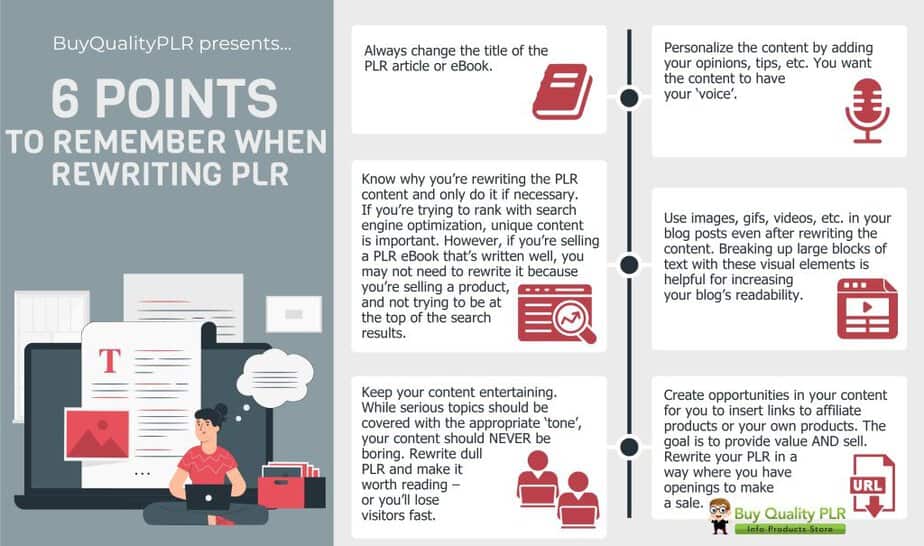
Adding Your Unique Flavor: Infusing PLR Content with Your Voice and Expertise
The true magic of PLR customization lies in infusing it with your own unique voice and expertise. You not only differentiate your content, but you also establish yourself as an authority in your niche. Here’s how to breathe life into PLR content:
Share Personal Insights and Experiences:
- Anecdotes and Stories: Relate the content to your own experiences or observations. Share personal anecdotes, client stories, or case studies that illustrate the key points and make the content more relatable and engaging.
- Opinions and Perspectives: Don’t shy away from expressing your opinions and viewpoints on the topic. Share your unique take on the information presented in the PLR content, offering a fresh perspective to your audience.
- Tips and Advice: Using your expertise, provide additional tips, advice, or strategies that extend beyond the fundamental information in the PLR content.
Updating Information and Statistics:
- Fact-Checking: Always verify the accuracy of the information presented in the PLR content. Look for the latest research, statistics, and industry trends to ensure your content is up-to-date and relevant.
- Incorporating New Data: If the PLR content is outdated, update it with the latest information. This demonstrates your commitment to providing accurate and valuable content to your audience.
- Citing Sources: When adding new information or statistics, be sure to cite your sources. This adds credibility to your content and shows your audience that you have done your research.
Finding Your Voice:
- Write in Your Own Style: Don’t try to mimic the original PLR content’s writing style.Instead, write in your own natural voice, using language and phrasing that you would typically use.
- Be Authentic: Let your personality shine through in your writing. Share your unique perspectives, opinions, and experiences to create a genuine connection with your audience.
- Speak to Your Audience: As you customize the content, keep your target audience in mind. Use language and examples that resonate with them, addressing their specific needs and interests.
By infusing PLR content with your personal touch, you can create a more engaging, informative, and valuable resource for your audience. This not only helps you stand out from the competition but also builds trust and credibility with your readers, ultimately leading to greater success in your business.
Elevating Your PLR Content: Making It Relatable, Engaging, and On-Brand
Beyond the basics of rewriting and updating, taking your PLR content to the next level involves making it more relatable, visually appealing, and aligned with your brand identity. These final touches can significantly impact how your audience perceives and engages with your content.
Adding Original Examples and Case Studies:
- Real-World Relevance: Use real-world examples to illustrate abstract concepts or theoretical advice.This helps your audience understand the practical applications of the information and visualize how it can be implemented.
- Relatable Scenarios: Share scenarios or stories that your target audience can relate to. This creates an emotional connection and makes the content more engaging.
- Case Studies: Showcase successful outcomes or transformations achieved by others using the strategies or advice presented in your content. This serves as social proof and builds trust with your audience.
Example: If your PLR article is about time management, you could include a case study of a busy entrepreneur who implemented the techniques and doubled their productivity.
Adding Visual Elements:
- Images: Replace text-heavy content with appropriate images.This not only makes the content more visually appealing but also aids in comprehension and retention.
- Infographics: Condense complex information into easily digestible visual formats, such as infographics or charts.This makes the content more shareable on social media and other platforms.
- Videos: If applicable, create short videos summarizing key points or demonstrating a process. Videos are highly engaging and can significantly boost your content’s reach.
Example: For a PLR ebook on healthy eating, you could include infographics summarizing nutritional information or videos demonstrating healthy recipes.
Creating a Consistent Brand Voice:
- Define Your Brand Personality: Clarify your brand’s personality traits (e.g., friendly, authoritative, humorous). This will guide your tone and style choices.
- Consistent Language and Terminology: Throughout your content, use consistent language, terminology, and phrasing. This creates a cohesive brand experience for your audience.
- Visual Branding: Ensure your visuals, such as logos, fonts, and colors, align with your overall brand identity. This reinforces brand recognition and builds trust with your audience.
Example: If your brand is known for its friendly and approachable tone, ensure your PLR content reflects this through conversational language and relatable examples.
By implementing these strategies, you can transform generic PLR content into unique, engaging, and on-brand assets that effectively resonate with your audience and contribute to the growth of your business.

Customizing PLR Articles and Blog Posts: A Step-by-Step Guide
PLR articles and blog posts provide a solid foundation for your content marketing strategy, but customization is key to making them truly shine and resonate with your audience. Here’s how to turn generic PLR content into unique, engaging pieces:
- Rewrite the Introduction and Conclusion:
- Hook Your Reader: Start with a captivating introduction that grabs attention and entices readers to continue. Personal anecdotes, thought-provoking questions, or relevant statistics can be effective hooks.
- Summarizing Your Points: In the conclusion, summarize the main takeaways and leave readers with a clear call to action. Encourage them to comment, share, or explore related resources.
- Infuse Your Brand Voice:
- Language and Tone: Adapt the writing style to match your brand’s voice and personality. Use language that resonates with your target audience and aligns with your brand’s values.
- Personal Touch: Add your own insights, opinions, and experiences to the article. Share personal anecdotes or examples that illustrate your points.
- Update and Expand Content:
- Fact Check: Ensure all facts and statistics are accurate and up-to-date. Replace outdated information with the latest data or research.
- Add Value: Expand on existing ideas by providing additional details, examples, or case studies. Dive deeper into specific topics that are relevant to your audience.
- Optimize for SEO:
- Keyword Research: Identify relevant keywords that your target audience is searching for and incorporate them naturally into the article.
- Meta Descriptions and Tags: Create compelling meta descriptions and tags that accurately reflect the article’s content and encourage clicks.
- Internal and External Linking: Link to other relevant articles on your website or external sources to provide additional context and improve your website’s search engine ranking.
- Format for Readability:
- Headings and Subheadings: To break down the content into easily digestible sections, use clear headings and subheadings.
- Short Paragraphs and Sentences: To improve readability, keep your paragraphs and sentences short and concise.
- Bullet Points and Lists: To present information in a clear and organized manner, use bullet points and numbered lists.
- Visuals: Incorporate relevant images, infographics, or videos to enhance the visual appeal of your article and break up long blocks of text.
- Call to Action:
- Clear and Compelling: Include a clear call to action at the end of your article, encouraging readers to take the next step, such as subscribing to your newsletter, downloading a free resource, or purchasing a product.
By implementing these tips, you can transform generic PLR articles into high-quality, engaging content that aligns with your brand and resonates with your target audience. Remember, the key is to make the content your own and provide unique value to your readers. With consistent effort and a focus on quality, PLR can become a powerful tool in your content marketing strategy.
Breathing New Life into PLR Ebooks and Reports: Strategies for Customization and Value Enhancement
PLR ebooks and reports offer a wealth of information, but often need a personal touch to truly resonate with your audience and stand out in the market. Here’s how to revamp these resources for maximum impact:
Restructure the Content:
- Reorganize Chapters: Rearrange the existing chapters or sections to create a more logical flow or align with your specific teaching style.
- Add New Chapters: Introduce entirely new chapters that delve deeper into specific topics or address areas not covered in the original PLR content.
- Create Summaries: Summarize key takeaways at the beginning or end of each chapter to enhance readability and reinforce learning.
Reformat for Visual Appeal:
- Typography and Layout: Choose visually appealing fonts, use appropriate spacing, and create a visually consistent layout throughout the ebook.
- Visuals: Incorporate relevant images, infographics, charts, and graphs to break up text and enhance understanding.
- Branding: Customize the cover, headers, footers, and other design elements to align with your brand identity and create a cohesive look.
Enhance with Additional Content:
- Personal Stories and Examples: Share your own experiences, anecdotes, or case studies to make the content more relatable and engaging.
- Expert Interviews: To add credibility and diverse perspectives to your ebook, interview industry experts or thought leaders.
- Bonus Resources: Offer additional resources like worksheets, checklists, templates, or access to a private community to provide extra value to your customers.
Update and Expand Information:
- Fact-Checking: Ensure all facts, statistics, and references are accurate and up-to-date.
- Adding New Research: Incorporate the latest research, studies, or industry trends to keep your ebook current and relevant.
- Expanding on Key Points: Elaborate on specific concepts or ideas that resonate with your audience, providing deeper insights and analysis.
Convert to Different Formats:
- Audiobooks: To cater to auditory learners and offer a convenient alternative format, transform your ebook into an audiobook.
- Online Course: Break down your ebook into modules and create an online course, adding interactive elements like quizzes, assignments, and discussions.
- Workbooks and Worksheets: Extract key points and exercises from the ebook to create accompanying workbooks or worksheets for practical application.
By implementing these strategies, you can transform generic PLR ebooks and reports into valuable, high-quality resources that reflect your expertise and cater to your audience’s unique needs. This will not only increase the perceived value of your products but also help you establish yourself as a trusted authority in your niche.

Breathing New Life into PLR Courses and Workshops: Your Expertise, Their Success
Transforming PLR courses and workshops into unique, engaging learning experiences requires a strategic approach. By blending your expertise with pre-made materials, you can create valuable educational products that resonate with your audience and establish you as an authority in your field.
Comprehensive Content Review:
- Understanding the Material: Thoroughly review the PLR course or workshop materials to grasp the key concepts, structure, and learning objectives.
- Identifying Gaps and Opportunities: Evaluate the content to see if there are any gaps in information or areas where you can provide additional insights, examples, or case studies based on your expertise.
- Adapting to Your Audience: Consider your target audience’s learning styles, preferences, and knowledge level. Tailor the content accordingly to ensure it’s engaging and relevant.
Infusing Your Expertise:
- Personalize the Introduction: Introduce yourself and your background, highlighting your experience and qualifications related to the course topic. This builds credibility and establishes a connection with your audience.
- Add Your Voice and Perspective: Share personal anecdotes, examples, and insights throughout the course. This adds a unique touch and makes the content more relatable and memorable.
- Offer Additional Resources: Supplement the PLR materials with your own resources, such as worksheets, checklists, templates, or bonus videos.
- Create Supplementary Content: Develop additional modules, lessons, or activities that delve deeper into specific topics or address areas not covered in the original content.
- Provide Expert Guidance: Offer personalized feedback, answer questions, and provide additional support to students through email, forums, or live Q&A sessions.
Enhancing the Learning Experience:
- Interactive Elements: Incorporate interactive elements like quizzes, polls, or discussions to keep learners engaged and assess their understanding.
- Multimedia: Enhance the course with videos, audio recordings, or slideshows to appeal to different learning styles.
- Assignments and Projects: Encourage active learning by assigning practical tasks or projects that allow students to apply the knowledge they’ve gained.
- Gamification: Incorporate gamification elements like badges, points, or leaderboards to make the learning experience more fun and motivating.
Branding and Customization:
- Visually Appealing Design: Create a visually consistent and professional look for your course materials, including slides, worksheets, and other resources.
- Branding Elements: Incorporate your logo, brand colors, and other visual elements throughout the course to reinforce your brand identity.
- Personalized Communication: Use a consistent tone and voice in your communication with students, reflecting your brand’s personality and values.
By strategically customizing PLR course materials and infusing them with your unique expertise, you can create high-quality educational products that differentiate you from the competition, attract and retain students, and ultimately generate a sustainable income stream.
Customizing PLR Content: Making Your Mark on Social Media and Beyond
Social Media Content:
To create engaging social media posts from PLR content, a strategic approach is required to capture attention and encourage interaction.
Here’s how to make your posts stand out:
- Visuals: Pair your PLR text with eye-catching images, graphics, or videos to increase engagement. Design platforms like Canva offer customizable templates to help you create professional-looking visuals quickly.
- Micro-Content: Break down lengthy PLR articles into bite-sized snippets, quotes, or tips that are perfect for sharing on social media.
- Questions and Prompts: Pose thought-provoking questions or conversation starters to encourage comments and discussion.
- Personalize: Add your own commentary, insights, or experiences to the PLR content to give it a personal touch and make it unique to your brand.
- Hashtags: Use relevant hashtags to increase your posts’ discoverability and reach a wider audience.
- Call to Action: Include a clear call to action in your posts, such as asking followers to share their thoughts, visit your website, or check out your latest product.
Other PLR Products:
- Software: Customize the interface, branding, and functionality of PLR software to match your brand identity and target audience. Consider adding new features or functionalities to differentiate your offering.
- Templates: Modify PLR templates, such as website themes, email templates, or social media graphics, by changing colors, fonts, and layouts. Add your own branding elements to create a cohesive look.
- Graphics: Edit PLR graphics to suit your specific needs. This could involve resizing, cropping, adding text overlays, or changing colors.
- Audio and Video: Use PLR audio or video clips as a base for creating unique content. Add your own voiceovers, music, or visual effects to make it more engaging.
Remember, the key to customizing PLR content is to add value and make it your own. By putting in the effort to personalize and enhance PLR products, you can create a unique brand identity, build trust with your audience, and ultimately increase your success in the online marketplace.

Empowering Your PLR Transformation with the Right Tools
To effectively customize PLR content, having the right tools at your disposal is essential. Here are some recommended software options to streamline your editing process and elevate your PLR content:
Word Processors:
- Microsoft Word: A versatile word processor with comprehensive features for editing, formatting, and collaborating on text-based documents. It also offers a built-in feature to save files as PDFs.
- Google Docs: A cloud-based alternative to Word, offering real-time collaboration, easy access from any device, and seamless integration with other Google tools.
- OpenOffice Writer: A free and open-source word processor that provides similar functionality to Microsoft Word, making it a budget-friendly option.
Graphic Design Tools:
- Canva: A user-friendly design platform with a wide array of templates, images, and elements, perfect for creating eye-catching graphics, social media posts, ebooks, and presentations.
- Adobe Photoshop/Illustrator: Industry-standard software for professional photo editing and graphic design, offering advanced features for creating stunning visuals.
- GIMP: A free and open-source alternative to Photoshop, providing a comprehensive range of tools for image manipulation and design.
- Pixelied: An online image editor that allows easy resizing, cropping, and enhancing of images to make them look more professional.
- Pixel Studio FX 3.0: Specifically designed to create 3D eCovers and mockups, this powerful tool adds a professional touch to your PLR products.
PDF Editors:
- Adobe Acrobat: The most popular PDF editor, offering extensive features for editing, annotating, combining, and converting PDF files.
- PDFescape: A free online PDF editor that allows you to add text, images, and annotations to your PDF files.
- Smallpdf: Another online PDF editor with a simple interface and various tools for converting, compressing, and editing PDF files.
Other Software:
- Scrivener: This writing software is ideal for organizing and managing large writing projects like ebooks and courses. It allows you to break down content into manageable sections and easily rearrange them.
- Quillbot: This paraphrasing tool can help you quickly rephrase sentences and paragraphs, ensuring originality and improving readability. It also offers a grammar checker to refine your writing.
By leveraging these tools, you can streamline your PLR content customization process, add your unique touch, create high-quality products that resonate with your audience, and drive your business forward.
Plagiarism Checkers: Safeguarding Originality and Avoiding Duplicate Content Issues
While PLR content grants you the right to use and modify existing material, it’s crucial to ensure that your customizations result in unique content. Plagiarism, even unintentional, can damage your reputation and lead to legal issues.
Here are some effective tools to help you check for originality:
- Grammarly: This popular writing assistant goes beyond grammar and spelling checks. Its built-in plagiarism detector scans your content against billions of web pages to identify any potential matches or similarities. It also offers suggestions for rephrasing to ensure your content is unique.
- Copyscape: This dedicated plagiarism checker specializes in scanning the web for duplicate content. It compares your text against online sources, highlighting any potential plagiarism issues. Copyscape is a valuable tool for identifying accidental plagiarism and ensuring your PLR customizations are truly original.
- Quetext: Using AI-powered technology, Quetext goes beyond simple word-for-word comparisons to analyze your content’s context and meaning. It provides detailed reports highlighting any potential plagiarism and suggests alternative phrasing to enhance originality.
Organizational Tools: Streamlining Your PLR Workflow
As your PLR library expands, maintaining organization becomes essential for efficient customization and content management. Here are some valuable tools to help you streamline your workflow:
- Project Management Tools:
- Trello: This visual project management tool allows you to create boards, lists, and cards to organize your PLR projects, track progress, and assign tasks to team members.
- Asana: A comprehensive project management platform that offers features like task management, timelines, calendars, and communication tools to streamline collaboration and ensure deadlines are met.
- Cloud Storage Platforms:
- Google Drive: This versatile cloud storage platform offers ample storage space for your PLR files, easy access from any device, and collaborative features for seamless teamwork.
- Dropbox: Another popular cloud storage option that allows you to store and sync your PLR content across multiple devices, ensuring you always have the latest version at your fingertips.
- OneDrive: Integrated with the Microsoft Office suite, OneDrive offers cloud storage and collaboration features that can be handy for working with PLR content in Word, Excel, or PowerPoint.
- Amazon S3: This scalable and highly secure cloud storage service is ideal for hosting large amounts of digital files, including PLR content. It is very affordable and offers a 1-year free tier for new customers, providing 5 GB of free storage.
Using these plagiarism checkers and organizational tools, you can confidently customize your PLR content while ensuring originality and maintaining an efficient workflow. Remember, organized and unique content is key to building a successful and reputable online presence.

Enhance Your PLR Content with Free Visuals: Top Resources for Royalty-Free and Public Domain Media
Incorporating high-quality visuals into your customized PLR content can significantly enhance its appeal and engagement. Fortunately, there are numerous resources available that provide free images and videos for commercial use, enabling you to elevate your content without incurring significant costs. Here are some of the best:
Royalty-Free Image Libraries:
- Unsplash: A vast collection of stunning, high-resolution photos covering a wide range of topics and styles. All images are free to use for commercial and personal projects.
- Pexels: Similar to Unsplash, Pexels offers a vast library of free stock photos and videos contributed by talented photographers and videographers worldwide.
- Pixabay: This platform hosts millions of free images, illustrations, vector graphics, and videos. It’s a one-stop shop for diverse visual content, with a convenient search function and filters to refine your search.
Public Domain Image Resources:
- Wikimedia Commons: A repository of over 90 million freely usable media files, including images, videos, and audio recordings. These files are either in the public domain or have licenses that allow for free use and modification.
- The British Library’s Digital Collections: This vast collection features millions of digitized items from the British Library’s collection, including historical photographs, maps, manuscripts, and more. The public domain allows for the free use of many of these items.
- New York Public Library Digital Collections: This library offers a rich collection of historical photographs, prints, maps, and other visual materials, many of which are in the public domain.
Additional Tips:
- Read the Fine Print: While these resources offer free content, it’s crucial to review the licensing terms for each image or video before using it. Some may require attribution or have specific restrictions on commercial use.
- Give Credit: When using public domain or Creative Commons licensed content, always give proper credit to the original creator. This is not only ethical but often a requirement of the license.
- Edit and Customize: Don’t just use the images and videos as-is. Edit, crop, or resize them to suit your specific needs, and incorporate your branding elements to create a cohesive look.
By leveraging these free resources and incorporating high-quality visuals into your PLR content, you can elevate its appeal, engage your audience, and create a more professional and polished brand image.
Best Platforms to Use for Selling PLR Digital Products
When venturing into the PLR market, choosing the right platform to sell your digital products can significantly impact your success. Here are three powerful platforms that offer comprehensive features and benefits tailored for PLR sellers:
Platforms:
- Etsy: A popular marketplace known for handmade and vintage items, Etsy also allows for the sale of digital downloads. This platform can be a great option for beginners, as it provides a built-in audience and easy-to-use tools for listing and selling products.
- Shopify: A leading e-commerce platform that offers a wide range of customizable features, allowing you to create a professional online store tailored to your brand. Shopify provides robust tools for inventory management, payment processing, marketing, and customer support.
- Podia: Specifically designed for creators and online course sellers, Podia offers a seamless platform for selling digital products, memberships, and online courses. It includes features like email marketing, affiliate marketing, and community building tools to help you grow your audience and revenue.
Tools for Selling Digital Products:
- GrooveFunnels: This all-in-one platform empowers entrepreneurs to build a complete online business ecosystem. With a user-friendly drag-and-drop interface, you can easily create high-converting sales funnels, professional websites, and engaging membership sites without any coding knowledge. GrooveFunnels‘ integrated email marketing tools allow you to build your list, nurture leads, and automate email campaigns, ensuring your PLR products reach the right audience. Additionally, its affiliate program management system enables you to recruit and manage affiliates, expanding your reach and sales potential.
- ProductDyno: Designed specifically for selling digital products, it provides a secure and seamless experience for both you and your customers. It guarantees the safe delivery of your PLR products, guarding against unauthorized access and piracy. With its flexible membership options, you can cater to different customer segments by creating various membership levels with unique access and pricing structures. Additionally, the platform’s drip content feature allows you to schedule the release of your content over time, keeping your customers engaged and coming back for more.
- System.io: This all-in-one marketing platform simplifies the entire sales process, from creating sales funnels to managing email lists and selling products. Its user-friendly interface and affordable pricing plans make it an ideal choice for beginners and budget-conscious entrepreneurs. With System.io, you can easily build landing pages, automate email sequences, manage affiliates, and sell your PLR products directly on the platform. Its intuitive design and automation capabilities save you time and effort, allowing you to focus on growing your PLR business.
By carefully considering the unique features and benefits of each platform and tool, you can choose the combination that best aligns with your specific needs and goals. Whether you need a marketplace for initial exposure, a customizable storefront, or a comprehensive marketing solution, these platforms and tools can empower you to create a successful and profitable PLR business.
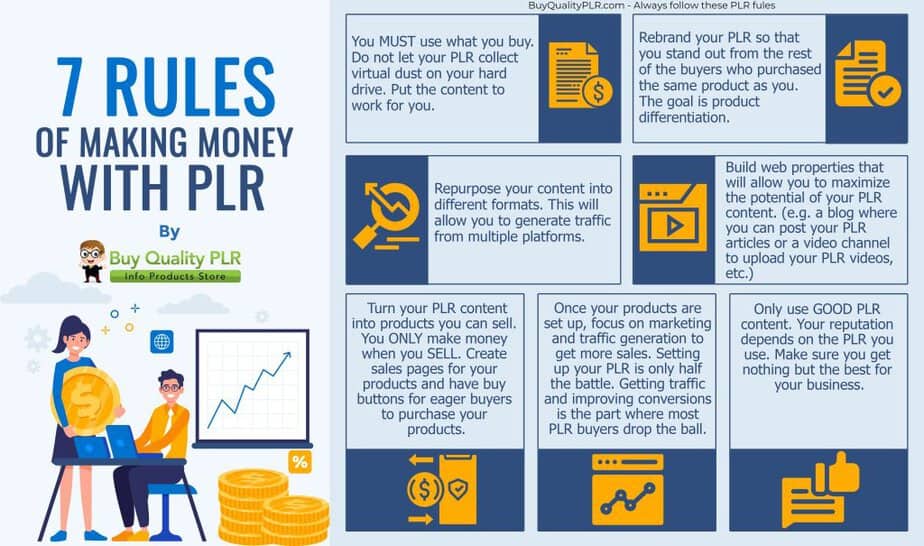
Crafting Persuasive Sales Pages and Product Descriptions
Compelling copywriting is the key to turning your PLR products into sales.
Here’s how to create effective sales pages and product descriptions:
- Headline: Capture attention with a clear, concise, and benefit-driven headline.
- Introduction: Engage your audience with a story or problem they can relate to.
- Features & Benefits: Clearly list the product’s features and explain how each one benefits the customer. Focus on the results and outcomes your product delivers.
- Social Proof: Showcase testimonials or reviews from satisfied customers to build credibility.
- Call-to-Action (CTA): Use a strong CTA that tells your audience exactly what to do (e.g., “Buy Now,” “Download Today”).
- Guarantee: Offer a money-back guarantee to alleviate any doubts or concerns.
- Formatting: Use short paragraphs, bullet points, and subheadings to make your copy easy to read and scan.
- Visuals: Include high-quality images or videos that showcase your product.
Leveraging Social Media and Email Marketing for Promotion
Effective promotion on social media and through email marketing can significantly expand your PLR product’s reach:
- Social Media:
- Share engaging posts with snippets of your PLR content.
- Run contests or giveaways to generate interest.
- Use targeted ads to reach specific audiences.
- Interact with your followers and answer questions.
- Email Marketing:
- Send regular newsletters highlighting new products and promotions.
- Segment your list to send personalized recommendations.
- Offer exclusive discounts or bonuses to e-mail subscribers.
- Use email sequences to nurture leads and build relationships.
Building an Email List with PLR Content
PLR content can be a powerful lead magnet to attract potential customers and grow your email list:
- Choose Relevant Content: Select PLR products that align with your target audience’s interests and pain points.
- Create a Landing Page: Design a landing page showcasing the value of your free PLR product and include a sign-up form.
- Promote Your Offer: Share your landing page on social media, on your website, or through paid advertising.
- Nurture Leads: Send a welcome email with a download link, and continue to nurture your leads with valuable content and promotions.
By combining compelling copywriting, strategic social media marketing, and effective lead magnets, you can successfully promote your customized PLR products and build a thriving online business.
Conclusion
In conclusion, the world of PLR digital products offers a vast landscape of opportunities for aspiring entrepreneurs and content creators. By identifying profitable niches, selecting reputable providers, and employing effective marketing strategies, you can unlock a sustainable and rewarding path to passive income.
The key to success lies in understanding your target audience, choosing high-quality PLR content that aligns with their needs, and customizing it to reflect your unique brand voice. Whether you’re selling PLR products directly, using them as lead magnets, incorporating them into your content marketing strategy, or building a membership site, the possibilities are endless.
Remember, the PLR market is constantly evolving. Stay informed about the latest trends, explore new niches, and continuously refine your approach to ensure your business thrives. By embracing the power of PLR and investing in your personal and professional growth, you can achieve your entrepreneurial dreams and create a fulfilling and financially rewarding online business.


